28 Apr Cultivating Creativity with Jason Ebinger
[vc_row css_animation="" row_type="row" use_row_as_full_screen_section="no" type="full_width"...

[vc_row css_animation="" row_type="row" use_row_as_full_screen_section="no" type="full_width"...
[vc_row css_animation="" row_type="row" use_row_as_full_screen_section="no" type="full_width"...
[vc_row css_animation="" row_type="row" use_row_as_full_screen_section="no" type="full_width"...
We would like to extend...
Donna Glee Williams, is a...
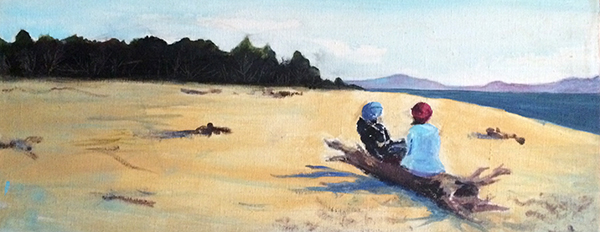 Painting by Sara Boggs[/caption]
Every time I see Sara Boggs around campus, like a giddy child, I ask her: "Can I see your sketchbook?" She always says "yes." You see, Sara is one of those artists who constantly carries her handmade sketchbook around, capturing tiny moments of life here and there - taking the time to practice and develop her drawing ability everyday. It has been incredible to see her book grow with the faces, places, and the spirit of the Folk School during her host term this fall. She permitted me to scan in some pages from her book to share with you. We also sat down over cookies and tea to talk about her experience as host and artistic journaler.
[caption id="attachment_12174" align="alignright" width="229"]
Painting by Sara Boggs[/caption]
Every time I see Sara Boggs around campus, like a giddy child, I ask her: "Can I see your sketchbook?" She always says "yes." You see, Sara is one of those artists who constantly carries her handmade sketchbook around, capturing tiny moments of life here and there - taking the time to practice and develop her drawing ability everyday. It has been incredible to see her book grow with the faces, places, and the spirit of the Folk School during her host term this fall. She permitted me to scan in some pages from her book to share with you. We also sat down over cookies and tea to talk about her experience as host and artistic journaler.
[caption id="attachment_12174" align="alignright" width="229"]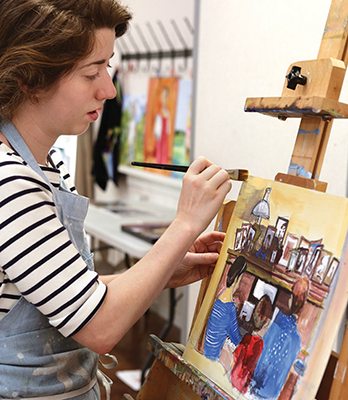 Sara in the Folk School Painting Studio[/caption]
CP: You were recently a character in the night of Holiday Revelry hosted by David Vowell. Who did you play?
SB: I got to play a couple of different characters: an all around reveler drinking wassail, the Little Pickle Boy in one of the tales about St. Nicholas, and Jack the Green in the mummer’s play. Jack’s character is traditionally full of mischief! In our play, Jack the Green saves the day in the story of St. George and the Dragon.
CP: Very nice. So you are wrapping up your host term at the Folk School? What's been your favorite part of being host?
SB: It’s the people… it’s for sure the people. Every week, I get to meet all of these wonderful people with amazing stories and wonderful things that they have done. They are all so sweet and encouraging – they make me feel like this world we have here that’s not quite real life – this fairy tale world that’s all fiddle music and blacksmith coal – is something that we can carry always. It’s been really wonderful to meet them all.
CP: Do you have any specific memories that resonate with you?
SB: There have been quite a few. Maybe it was because it was so early on in my time here, but one that sticks out is a magical cooking class dinner party. The class was a wood fired cooking class and they had their Thursday night dinner outside on picnic tables, with candle light torches. There was wine, and ukelele music, and a beautiful pink sunset overhead… little dogs came wandering through. It was slow and delicious. I wasn’t even supposed to be there, I was just crashing, but they let me crash. It was a lovely evening and I felt like it was the right way to start off my foot here.
[caption id="attachment_12175" align="aligncenter" width="600"]
Sara in the Folk School Painting Studio[/caption]
CP: You were recently a character in the night of Holiday Revelry hosted by David Vowell. Who did you play?
SB: I got to play a couple of different characters: an all around reveler drinking wassail, the Little Pickle Boy in one of the tales about St. Nicholas, and Jack the Green in the mummer’s play. Jack’s character is traditionally full of mischief! In our play, Jack the Green saves the day in the story of St. George and the Dragon.
CP: Very nice. So you are wrapping up your host term at the Folk School? What's been your favorite part of being host?
SB: It’s the people… it’s for sure the people. Every week, I get to meet all of these wonderful people with amazing stories and wonderful things that they have done. They are all so sweet and encouraging – they make me feel like this world we have here that’s not quite real life – this fairy tale world that’s all fiddle music and blacksmith coal – is something that we can carry always. It’s been really wonderful to meet them all.
CP: Do you have any specific memories that resonate with you?
SB: There have been quite a few. Maybe it was because it was so early on in my time here, but one that sticks out is a magical cooking class dinner party. The class was a wood fired cooking class and they had their Thursday night dinner outside on picnic tables, with candle light torches. There was wine, and ukelele music, and a beautiful pink sunset overhead… little dogs came wandering through. It was slow and delicious. I wasn’t even supposed to be there, I was just crashing, but they let me crash. It was a lovely evening and I felt like it was the right way to start off my foot here.
[caption id="attachment_12175" align="aligncenter" width="600"]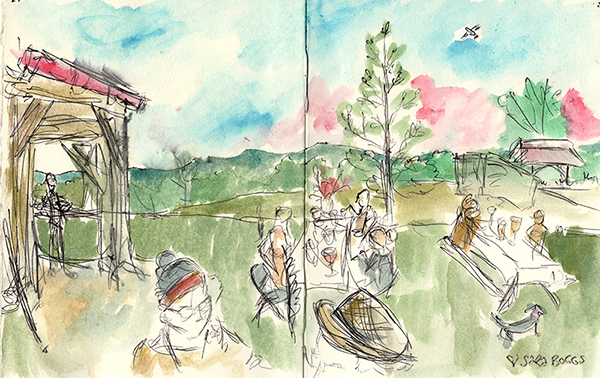 Page from Sara's sketchbook: Thursday night dinner party for the Cooking Class[/caption]
Page from Sara's sketchbook: Thursday night dinner party for the Cooking Class[/caption]
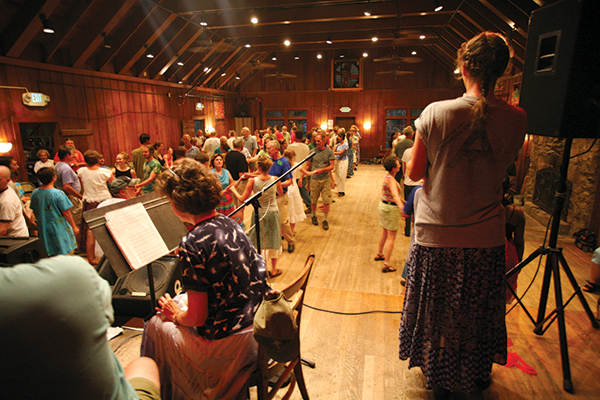 Charlotte calls a contra dance in the Community Room.[/caption]
CP: How long have you been calling at the Folk School?
CC: I came to the Folk School as a Work/Study in the winter of 2006 and I took Bob Dalsemer’s Dance Callers' Workshop that summer. So technically I’ve been calling since 2006, but I wasn’t calling regularly 'till a little time after that.
CP: Why did you get into dance calling?
CC: I’d been a contra dancer for a long time. When I was in elementary, high school and college I was involved in other kinds of dance, so I’ve always had a history of being interested in dancing. I wanted to be a provider of the activity as opposed to just a consumer. Recognizing that my skills as a musician might be a little lacking (laughs), I embraced calling as the next fun way I could be able to do that.
[caption id="attachment_11666" align="alignright" width="340"]
Charlotte calls a contra dance in the Community Room.[/caption]
CP: How long have you been calling at the Folk School?
CC: I came to the Folk School as a Work/Study in the winter of 2006 and I took Bob Dalsemer’s Dance Callers' Workshop that summer. So technically I’ve been calling since 2006, but I wasn’t calling regularly 'till a little time after that.
CP: Why did you get into dance calling?
CC: I’d been a contra dancer for a long time. When I was in elementary, high school and college I was involved in other kinds of dance, so I’ve always had a history of being interested in dancing. I wanted to be a provider of the activity as opposed to just a consumer. Recognizing that my skills as a musician might be a little lacking (laughs), I embraced calling as the next fun way I could be able to do that.
[caption id="attachment_11666" align="alignright" width="340"]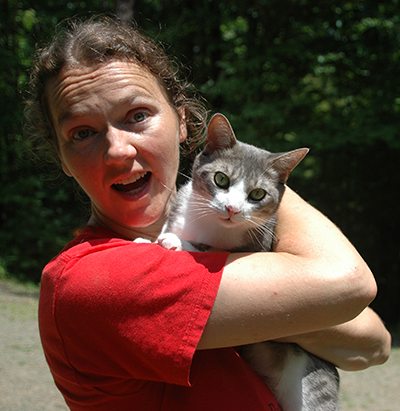 Charlotte & Charlie[/caption]
CP: What’s the best thing about calling a dance at the Folk School?
CC: What a good question! I’d say the dance community at the Folk School is one of the best for integrating all kinds of different folks. People who have been dancing for years and years and years are dancing on the same floor as those who have never ever done it before. Little kids all the way up to folks in their 70s and 80s - all on the same dance floor and everyone’s having a great time, enjoying each other's company. That’s the best part!
CP: Do you have a favorite tune?
CC: I really like the old time tune called Growling & Grumbling, which I love as a dance tune. It got this great low, mumbly beginning and then it busts into this fun, upbeat tune.
CP: Is that the same tune as Growling Old Man and Grumbling Old Woman?
CC: Yep! That’s the one! It a great tune.
CP: Where do you get your dances from?
CC: Oh goodness! Lots of sources. Primarily (and I’d say traditionally) from other callers, but also from going to other dances. I’ll go to a dance and enjoy something that I just danced, run over to the side and write it down real quick.
So I collect dances from dancing. I collect dances from other callers. And in our modern day & age, the internet is a wonderful place, not only to collect dances right off the web, but also to find literature from different places. I use the Country Dance & Song Society which is an organization up in Massachusetts that promotes folk dance and music. I peruse their bookstore pretty frequently. They are a great resource for all things dance.
Charlotte & Charlie[/caption]
CP: What’s the best thing about calling a dance at the Folk School?
CC: What a good question! I’d say the dance community at the Folk School is one of the best for integrating all kinds of different folks. People who have been dancing for years and years and years are dancing on the same floor as those who have never ever done it before. Little kids all the way up to folks in their 70s and 80s - all on the same dance floor and everyone’s having a great time, enjoying each other's company. That’s the best part!
CP: Do you have a favorite tune?
CC: I really like the old time tune called Growling & Grumbling, which I love as a dance tune. It got this great low, mumbly beginning and then it busts into this fun, upbeat tune.
CP: Is that the same tune as Growling Old Man and Grumbling Old Woman?
CC: Yep! That’s the one! It a great tune.
CP: Where do you get your dances from?
CC: Oh goodness! Lots of sources. Primarily (and I’d say traditionally) from other callers, but also from going to other dances. I’ll go to a dance and enjoy something that I just danced, run over to the side and write it down real quick.
So I collect dances from dancing. I collect dances from other callers. And in our modern day & age, the internet is a wonderful place, not only to collect dances right off the web, but also to find literature from different places. I use the Country Dance & Song Society which is an organization up in Massachusetts that promotes folk dance and music. I peruse their bookstore pretty frequently. They are a great resource for all things dance.
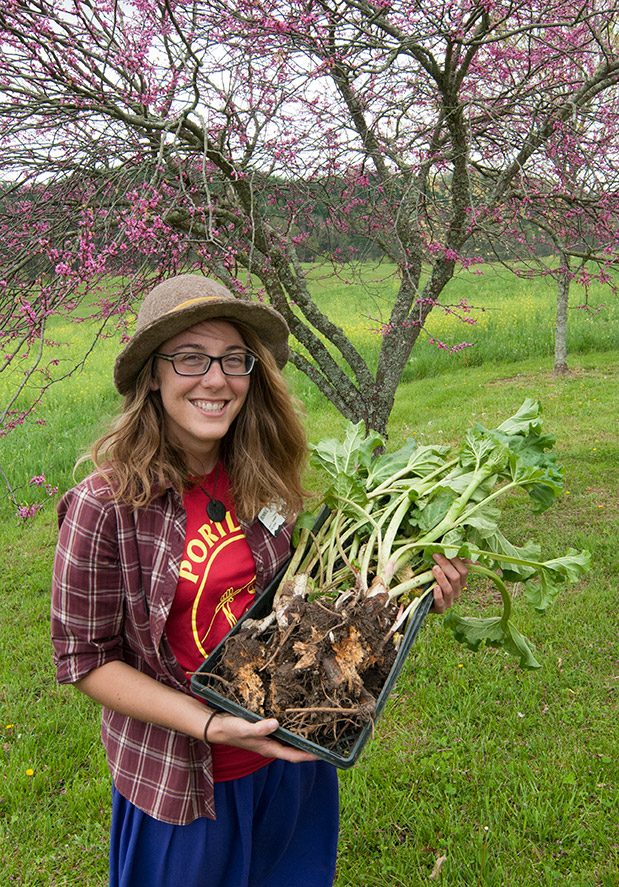 Bonnie wearing her favorite hat and gathering rhubarb from the Vegetable Garden for her Cooking Class.[/caption]
The hosts at the Folk School keep the show running smoothly. Unlike the year-round staff who go home at night and the regular students who are here for only a week, they are fully involved in the daily life of the School for a four month period. Without further ado… Let’s get to know a little bit about our current senior host, Bonnie Lenneman!
CP: Where are you from and what do you do there?
BL: I am originally from Michigan, but most recently I was working for a non-profit in Portland, Oregon.
CP: What about the Folk School appealed to you before you first came?
BL: Last spring I was leaving my job at the non-profit and I wanted to do something new & different that engaged both my artistic/creative side and also involved doing something outdoors. The Work/Study program was a perfect fit!* The Sing Behind the Plow motto also appealed to me - the idea of working more closely with the land and celebrating the simplicity and satisfaction of our labor. (*Bonnie came here first as a Work/Study in Fall 2013, now she is host)
Bonnie wearing her favorite hat and gathering rhubarb from the Vegetable Garden for her Cooking Class.[/caption]
The hosts at the Folk School keep the show running smoothly. Unlike the year-round staff who go home at night and the regular students who are here for only a week, they are fully involved in the daily life of the School for a four month period. Without further ado… Let’s get to know a little bit about our current senior host, Bonnie Lenneman!
CP: Where are you from and what do you do there?
BL: I am originally from Michigan, but most recently I was working for a non-profit in Portland, Oregon.
CP: What about the Folk School appealed to you before you first came?
BL: Last spring I was leaving my job at the non-profit and I wanted to do something new & different that engaged both my artistic/creative side and also involved doing something outdoors. The Work/Study program was a perfect fit!* The Sing Behind the Plow motto also appealed to me - the idea of working more closely with the land and celebrating the simplicity and satisfaction of our labor. (*Bonnie came here first as a Work/Study in Fall 2013, now she is host)
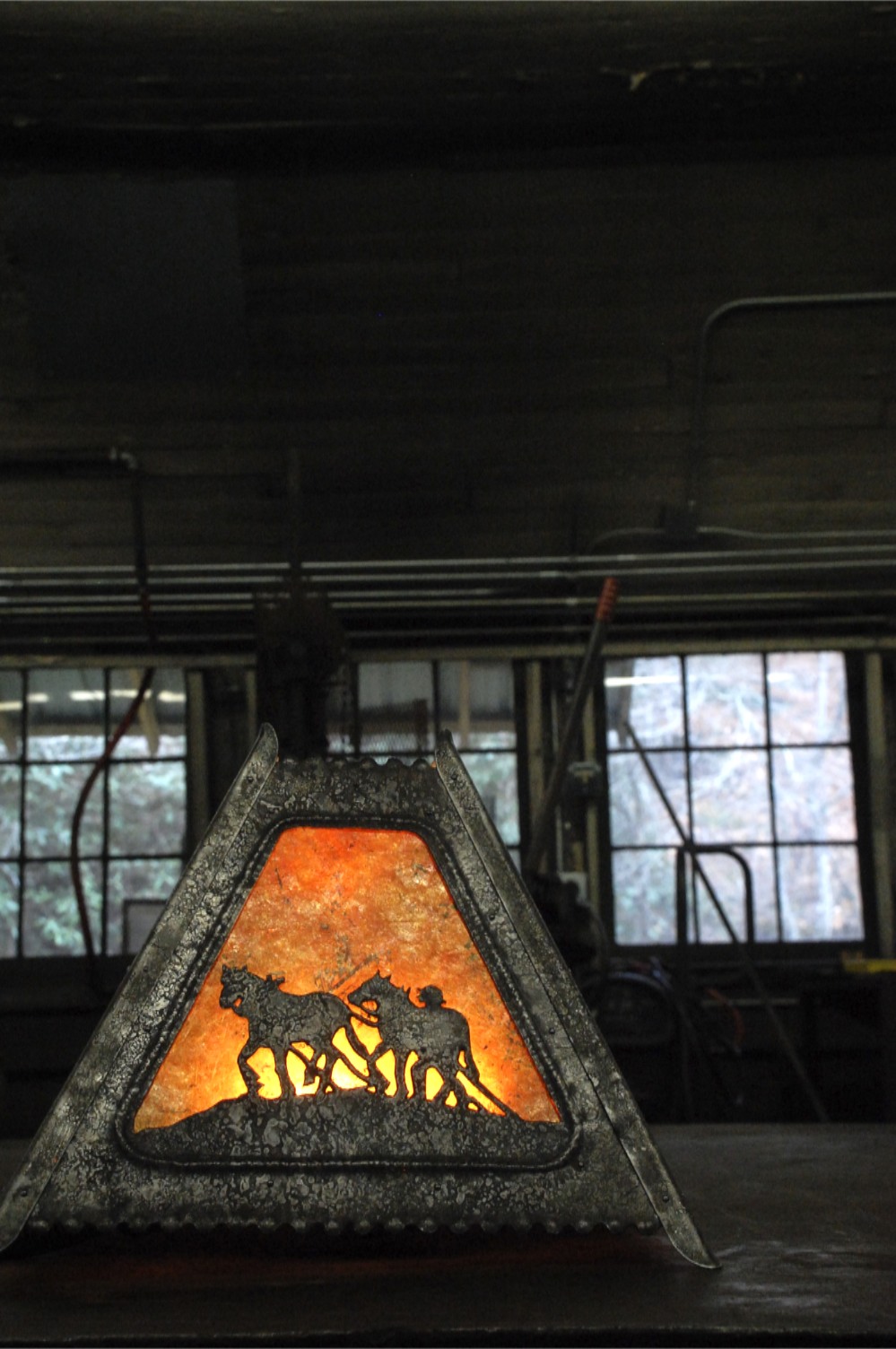 Sing Behind the Plow lampshade by Ron Nichols[/caption]
Blacksmith Work Week is an annual Folk School tradition, bringing 20 professional blacksmiths/instructors from around the country together to volunteer their time for the purposes of 1) beautifying the Folk School campus with functional ironwork; 2) repairing and creating new tools and infrastructure for the Blacksmithing program; and 3) spending a week learning and exchanging in the company of peers and mentors.Work Week was started by Clay Spencer (namesake of the new blacksmith shop) in the early 1990s and is currently coordinated by Paul Garrett, resident artist blacksmith. I had the chance to visit the shop and interview some of the blacksmiths as they put finishing touches on their projects and reflected on their connection to this very special community and yearly opportunity to participate in Work Week.
Leah Dolgoy: Paul, how’s it gone this week? What were your priority projects and what’s been accomplished during Work Week?
Paul Garrett: There were many priorities this year. One was making chandeliers for upstairs. They won’t get done this year but we’ll keep working on them next year. The shop is named after Clay Spencer so I gave Clay free reign on the design and he chose something very contemporary and out of the ordinary. Other priorities included work in some of the studios. We mounted some equipment for the Jewelry studio. We built a pot rack for the cooking studio. And we finished installing the door latches I made for the main door to the new blacksmith shop. We made two treadle hammers, and two treadle torches. We fixed a lot of tools – hammers and tongs, punches and grips. We also do whatever else pops up. I really wanted to do the Keith House door so that got done this year. We etched and epoxied the bathroom floor in the shop so that housekeeping can come in and clean it more easily now. Then there are all the little things that come up. I have these little job sheets that I put out and I find that works well. People pick their jobs based on their area of interest and expertise.
LD: What does it mean to be the coordinator of this thing that everyone regards as so special?
[caption id="attachment_10391" align="alignright" width="232"]
Sing Behind the Plow lampshade by Ron Nichols[/caption]
Blacksmith Work Week is an annual Folk School tradition, bringing 20 professional blacksmiths/instructors from around the country together to volunteer their time for the purposes of 1) beautifying the Folk School campus with functional ironwork; 2) repairing and creating new tools and infrastructure for the Blacksmithing program; and 3) spending a week learning and exchanging in the company of peers and mentors.Work Week was started by Clay Spencer (namesake of the new blacksmith shop) in the early 1990s and is currently coordinated by Paul Garrett, resident artist blacksmith. I had the chance to visit the shop and interview some of the blacksmiths as they put finishing touches on their projects and reflected on their connection to this very special community and yearly opportunity to participate in Work Week.
Leah Dolgoy: Paul, how’s it gone this week? What were your priority projects and what’s been accomplished during Work Week?
Paul Garrett: There were many priorities this year. One was making chandeliers for upstairs. They won’t get done this year but we’ll keep working on them next year. The shop is named after Clay Spencer so I gave Clay free reign on the design and he chose something very contemporary and out of the ordinary. Other priorities included work in some of the studios. We mounted some equipment for the Jewelry studio. We built a pot rack for the cooking studio. And we finished installing the door latches I made for the main door to the new blacksmith shop. We made two treadle hammers, and two treadle torches. We fixed a lot of tools – hammers and tongs, punches and grips. We also do whatever else pops up. I really wanted to do the Keith House door so that got done this year. We etched and epoxied the bathroom floor in the shop so that housekeeping can come in and clean it more easily now. Then there are all the little things that come up. I have these little job sheets that I put out and I find that works well. People pick their jobs based on their area of interest and expertise.
LD: What does it mean to be the coordinator of this thing that everyone regards as so special?
[caption id="attachment_10391" align="alignright" width="232"]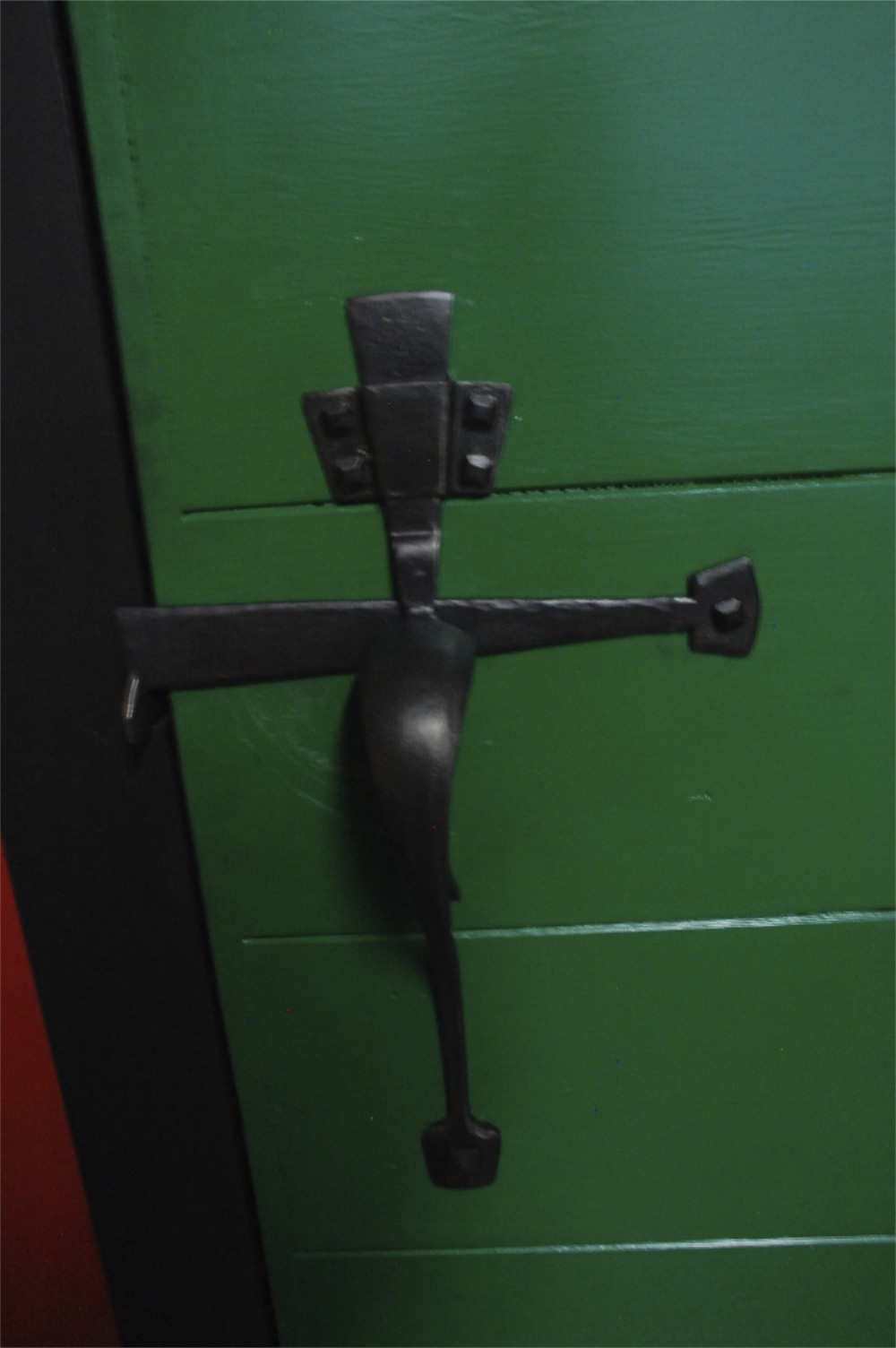 New door hardware for the Blacksmith Shop made by Paul Garrett[/caption]
PG: For me, it’s an honor and a privilege to be a part of Work Week. I just love having everyone here. As the coordinator, it’s up to me to make the most of it. We have 1000 hours of volunteer labor every year. My role is to keep everyone else working, and to make sure that they can get what they need to get the job done. Funny story - 13 or 14 years ago I came here as a student, and I asked Clay if I could come to Work Week. And basically he said no, because he had enough people and he didn’t really know me that well. (laughs) It wasn’t to be mean or anything. He just had his team that he needed. I understand that now that I am on the other side of it. I believe this is my 10th year as the Work Week coordinator.
New door hardware for the Blacksmith Shop made by Paul Garrett[/caption]
PG: For me, it’s an honor and a privilege to be a part of Work Week. I just love having everyone here. As the coordinator, it’s up to me to make the most of it. We have 1000 hours of volunteer labor every year. My role is to keep everyone else working, and to make sure that they can get what they need to get the job done. Funny story - 13 or 14 years ago I came here as a student, and I asked Clay if I could come to Work Week. And basically he said no, because he had enough people and he didn’t really know me that well. (laughs) It wasn’t to be mean or anything. He just had his team that he needed. I understand that now that I am on the other side of it. I believe this is my 10th year as the Work Week coordinator.
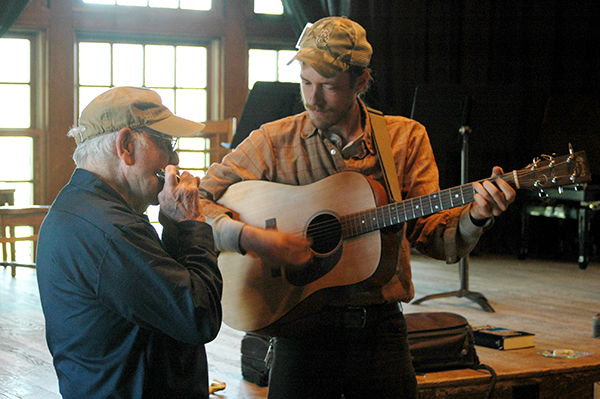 Cory and fellow Tinsmithing student play music in the Community Room after Show and Tell[/caption]
Cory and fellow Tinsmithing student play music in the Community Room after Show and Tell[/caption]
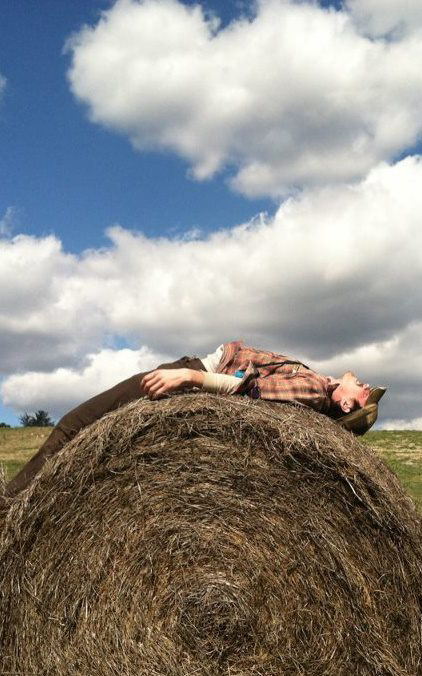 Laying on the hay in the Folk School field[/caption]
Laying on the hay in the Folk School field[/caption]
CP: When were you a Work/Study?
CS: March 14 – May 15, 2010. I remember the date clearly because I recall being mesmerized by the St. Patrick’s Day Party at the Murphy L & N Train Depot. Dale’s imitation of a leprechaun trapped in a brown paper bag - I thought that was brilliant!
CP: What have you been up to since your W/S session?
CS:I am currently a student at Berea College. I have been there for three years pursuing my undergraduate degree. I’ve also done a bit of working and traveling. I went to Ireland and Japan with the Berea Bluegrass Band. For a while before I went to Berea, I was working with Meredith Dahle (former host) at Sugarboo Farms in Blairsville. That was great because I could still be involved at the Folk School.


